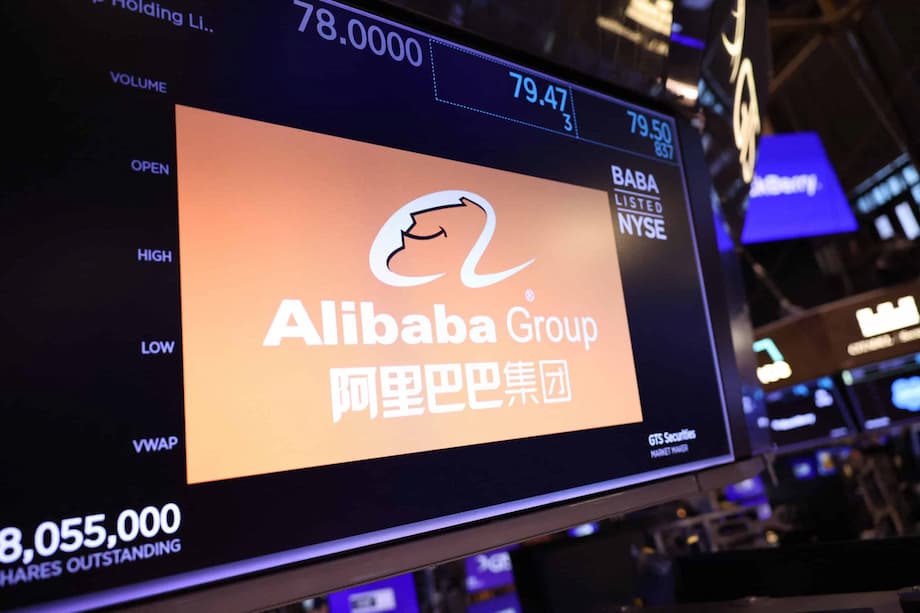Alibaba’s AI momentum turns Hong Kong into a rare bright spot
Hong Kong stocks broke away from a softer regional tone at the start of the week as investors piled into Alibaba after a powerful earnings-driven rebound in its cloud and artificial intelligence businesses. The Hang Seng Index rose about 2.2 percent to 25,617.42, its best single day in roughly two weeks, while Alibaba’s Hong Kong shares jumped nearly 19 percent, their biggest single day move in more than three years. Mainland benchmarks edged higher, with the CSI 300 up about 0.6 percent and the Shanghai Composite up 0.5 percent, as the rally in Chinese equities extended despite a weak lead from Wall Street.
- Alibaba’s AI momentum turns Hong Kong into a rare bright spot
- What powered Alibaba’s rally
- Hong Kong and mainland markets diverged from the region
- Inflation and interest rate signals cooled risk appetite
- Tariff and trade politics added uncertainty
- Ripple effects across emerging markets and Chinese tech
- Risks that still shadow Chinese tech
- Why this rally matters for Hong Kong’s discount
- Highlights
The rest of Asia mostly fell. Japan’s Nikkei dropped around 2 percent as technology shares tracked a pullback in United States peers late last week. Jakarta retreated by more than 2 percent after unrest tied to economic hardship left six people dead, weighing on risk appetite. Seoul’s Kospi also slipped even as South Korea reported record monthly semiconductor exports in August, a reminder that share prices can diverge from headline trade data when policy and valuation concerns dominate.
Alibaba’s surge followed a June quarter update that showed net income up 78 percent year on year to 43.11 billion yuan and revenue of 247.65 billion yuan, with the market fixated on the jump in cloud growth and AI related sales. The company reported a 26 percent rise in cloud division revenue to 33.4 billion yuan and said AI product revenue for external customers has maintained triple digit gains for eight straight quarters. Profit benefited from investment gains and asset disposals, including the exit from Turkish e commerce firm Trendyol, while underlying earnings in core commerce were pressured by heavy spending on instant delivery services.
Investors looked past the mixed top line and focused on evidence that Alibaba’s cloud assets are now a central route to monetizing AI workloads in China, which helped carry the broader Hang Seng Technology Index up about 2.2 percent. The rally came during thin trading conditions with the United States market shut for Labor Day, which can exaggerate moves, yet the scale of the advance hinted at renewed conviction around Chinese tech exposure after a choppy August.
What powered Alibaba’s rally
The market reaction turned on the idea that Alibaba’s growth is increasingly tied to its cloud and AI stack rather than only retail. While group revenue rose a modest 2 percent, the company’s most AI exposed unit accelerated and management gave a clear signal that demand from developers and enterprises is strengthening. Investors also reassessed valuation after a long stretch of underperformance, with the stock still far below its 2020 peak despite a strong year to date rebound.
Cloud and AI engine
Alibaba’s cloud division delivered 33.4 billion yuan in revenue, up 26 percent year on year, outpacing the prior quarter’s growth rate. Management said AI related product revenue has grown at a triple digit pace for eight consecutive quarters as clients deploy chat assistants, code generation, and industry specific models. The company is commercializing its Qwen family of models and selling inference, training, and application services through Alibaba Cloud. It is also developing a new AI chip to support model training and inference. Executives have indicated they aim to grow faster than the market in cloud, prioritizing scale and adoption over quick margin expansion, a stance that aligns with the land grab phase typical of AI infrastructure cycles.
For investors unfamiliar with the mechanics, AI demand lifts cloud revenue by increasing consumption of compute, storage, and networking. Customers pay for capacity to train models and for the inference workloads that run applications in production. That consumption based model turns AI interest into recurring revenue, which is why sustained triple digit growth in AI products carries weight for Alibaba’s valuation, even if near term profitability moves around as the company invests.
Instant commerce and the margin trade off
Alibaba is also spending heavily on “instant commerce,” a fast delivery feature within Taobao that aims to get goods to shoppers in roughly an hour. Management said revenue in that quick delivery segment reached more than 14.8 billion yuan in the quarter, up 12 percent year on year, and projected that instant commerce could add 1 trillion yuan in annualized incremental gross merchandise value within three years. The strategy helps defend market share against rivals that have leaned into rapid delivery, though it compresses near term margins in core commerce, which partly explains why underlying earnings in the division fell even as customer management revenue grew.
Hong Kong and mainland markets diverged from the region
While Hong Kong led gains, most Asian indices were weaker. The Hang Seng’s advance was amplified by its heavy tech weighting and by the outsized move in Alibaba, which carries significant index influence. The Hang Seng Technology Index moved in step, reflecting a broader bid across large internet names. Mainland markets extended a steady run, with the CSI 300 and Shanghai Composite both higher, as regulators signaled comfort with recent stabilization. In talks with academics and market professionals, China Securities Regulatory Commission chair Wu Qing said the ongoing stabilization and uptrend in domestic stocks should be further anchored, a comment that investors read as supportive.
Valuation also helped Hong Kong. According to market data, the Hang Seng trades around 11.8 times earnings, compared with about 18.2 times for the Shanghai Composite, a gap that has drawn buyers looking for perceived bargains after mainland shares hit decade highs last month. Beyond Alibaba, BOC Hong Kong gained about 6.7 percent after a double digit rise in first half profit, and Alibaba Health advanced near 7 percent.
Tokyo and Seoul lost ground
Japan’s market fell as technology sellers followed a United States pullback in high growth names. The retreat came after the prior week’s disappointment around some megacap earnings and renewed debate over the pace of monetary easing abroad. In South Korea, record monthly chip exports in August underscored strong demand for memory and logic components, yet stocks still eased amid concern that global rate cuts might arrive more slowly than hoped and that tariff headwinds could persist. Share indices often anticipate policy and liquidity shifts before trade statistics filter through to earnings.
Inflation and interest rate signals cooled risk appetite
Across global markets, a hotter United States inflation reading at the end of last week pushed investors to trim expectations for a series of rapid Federal Reserve rate cuts. Traders still see a quarter point reduction in September as likely, but the trajectory beyond that is less certain if price pressures keep firming. European data added to the caution after Germany’s inflation rate ticked higher in August for the first time this year, a development that could weigh on European Central Bank easing prospects.
Bret Kenwell, an analyst at eToro, put the shifting calculus bluntly after the latest data and Friday’s Wall Street dip.
Although a September cut of 25 points is probably still on the cards, it may be hard for them to move as quickly or aggressively as they’d like, with inflation moving higher.
With Wall Street closed for Labor Day and September often a choppy month for equities, many investors chose to take down risk rather than chase rallies outside Hong Kong. European stocks were mixed to modestly higher, oil prices nudged up, and currency moves were contained as traders waited for more concrete signals on the growth and inflation mix.
Tariff and trade politics added uncertainty
Trade policy returned to the headlines after a United States appeals court ruled that President Donald Trump exceeded his authority when invoking emergency economic powers to impose wide ranging duties. The ruling left the tariffs in place while legal proceedings continue, keeping a cloud over supply chains and corporate planning. The immediate market reaction was muted, but companies exposed to cross border flows remain sensitive to any change in the tariff regime.
Responding to the decision, Trump struck a defiant tone.
The United States of America will win in the end.
Tensions around trade positioning also surfaced in Japan. The country’s tariffs envoy reportedly canceled a planned trip to Washington amid talk of a presidential order that would include stepped up Japanese purchases of United States rice, according to local media. That backdrop added a layer of policy noise to a session already shaped by rate jitters and profit taking in technology names.
Ripple effects across emerging markets and Chinese tech
Alibaba’s jump did not just lift Hong Kong. A gauge of emerging market equities rose about 0.6 percent, snapping a losing streak as AI linked names in China and Hong Kong drew support following the cloud update. In Chinese tech, Alibaba’s near 19 percent move added more than 50 billion dollars in market value and pulled peers like Baidu and Tencent higher, with turnover hitting heavy levels in Hong Kong as investors rotated back into AI beneficiaries.
Morgan Stanley analysts described Alibaba as one of the strongest ways to invest in China’s AI build out given its cloud position and growing stack of developer tools. The bullish readout followed a year to date recovery that has seen Alibaba outperform many domestic peers while still trading far below its 2020 highs after a long regulatory chill on platform companies.
Eddie Wu, Alibaba’s chief executive officer, highlighted the demand picture that underpins the cloud and AI story.
Robust AI demand drove accelerated revenue growth, with AI related product revenue now a significant portion of revenue from external customers.
That message resonated with investors who are weighing whether AI can drive sustained consumption of cloud services across industries from retail to manufacturing. It also helped overshadow near term questions about margins in core commerce and the cost of defending market share in fast delivery.
Risks that still shadow Chinese tech
Regulatory and geopolitical risks have not disappeared, even with the latest rally. Export controls from the United States could restrict access to advanced chips, while future changes in domestic internet rules can affect product road maps and advertising or data practices. Reports earlier this year about a potential collaboration to bring new AI features to smartphones in China underscored both the opportunity and the complexity of navigating global partnerships under shifting rules.
Macro headwinds also linger. China continues to work through a drawn out real estate downturn and weak consumer sentiment. Analysts caution that a durable recovery in shares usually requires concrete progress in household income growth, housing stabilization, and confidence. That said, a large valuation discount and visible growth in cloud and AI give investors a clearer narrative than they had a year ago.
Why this rally matters for Hong Kong’s discount
One lesson from the session is that Hong Kong’s valuation gap can act like a spring when a credible growth spark appears. With the Hang Seng trading at a lower earnings multiple than major mainland indices, even modest fundamental beats can produce outsized price moves. Endorsements from regulators that the market’s stabilization should be strengthened adds a policy layer that supports risk taking when company news flow turns positive. If corporate updates continue to show traction in cloud, AI, and international e commerce, investors who have been underweight Hong Kong may keep rotating back, especially if domestic liquidity supports mainland shares near decade highs.
The balance of forces still favors caution across much of Asia. Sticky inflation, an uncertain rate path, and trade policy noise remain in the mix. The Alibaba driven pop showed that catalysts exist for Chinese tech, yet the next leg likely depends on consistent delivery in cloud and AI and a clearer picture on consumer demand at home.
Highlights
- Alibaba’s Hong Kong shares surged nearly 19 percent after an earnings update highlighted a 26 percent rise in cloud revenue and triple digit growth in AI product sales.
- The Hang Seng Index climbed about 2.2 percent to 25,617.42, outperforming most Asian markets that declined.
- Mainland benchmarks rose, with the CSI 300 up roughly 0.6 percent and the Shanghai Composite up 0.5 percent.
- Japan’s Nikkei fell around 2 percent and South Korea’s Kospi slipped despite record August semiconductor exports.
- Jakarta dropped more than 2 percent after deadly unrest tied to economic hardship dampened sentiment.
- A hotter United States inflation reading reduced expectations for a rapid series of Federal Reserve rate cuts, even if a quarter point move in September remains likely.
- Germany’s inflation rate rose in August for the first time this year, complicating European Central Bank easing hopes.
- A United States appeals court said President Donald Trump exceeded his authority in imposing certain tariffs, though the duties remain in place for now.
- Emerging market equities rose about 0.6 percent as Alibaba’s rally lifted AI related names; Chinese tech peers, including Baidu and Tencent, advanced.
- Valuation remains a draw for Hong Kong, with the Hang Seng around 11.8 times earnings versus roughly 18.2 times for the Shanghai Composite.
- Regulatory and export control risks persist for Chinese tech, while weak domestic demand and property stress still weigh on the macro backdrop.












